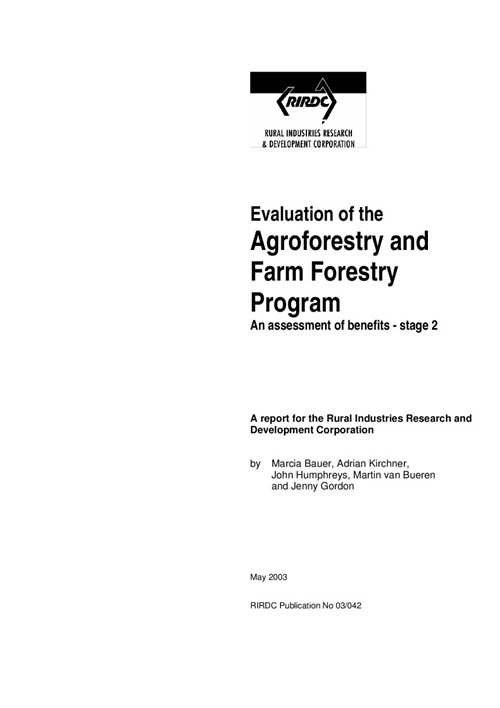AgriFutures Australia Annual Report 2024-25
This document is AgriFutures Australia’s Annual Report to government and industry stakeholders, covering the organisation’s operations for 2024–25. It is aligned with AgriFutures Australia’s Research...

169 pages
Published: 1 Jun 2005
Author(s): Bauer, Marcia, Kirchner, Adrian, Humphreys, John
Download report PDF
DownloadPurchase a hard copy - AUD $75.00
This report is part of an overall evaluation of the Agroforestry and Farm Forestry
Program, a sub-program under the Emerging Industries program. This is the fifth in a
series of evaluations and the first at the sub-program level. Given the size of the subprogram
and current public interest in replanting Australia, it is timely for the focus of
this year’s evaluation to be on Agroforestry. It is also an ideal candidate for triple
bottom line evaluation as the non-commercial benefits of trees are one of the
motivating factors for public interest. Part one of the report compiles a list of all
completed and current projects together with an assessment of their expected impact.
This part of the report provides a more in-depth assessment of the impacts of the R&D.
Four clusters of projects (covering 25 projects in all) are evaluated. The evaluation
method aimed to identify and quantify the environmental and social as well as the
economic benefits. The internal rates of return range between 11 and 24 per cent. The
relatively low values reflect the long delay between planting trees and reaping some of
the more commercial benefits. The net benefit investment ratios (NBIR) which estimate
the dollars return to each dollar of R&D invested range from 2 to 26. Overall the net
present value of the benefits from the 25 projects sum to around $100 million for an
investment of under $9 million in R&D.
The benefits from the R&D have accrued largely in terms of additional commercial
returns to farmers in terms of wood and projected carbon credit sales. The assessment
of environmental outcomes included the reduction in externalities from salinity,
biodiversity protection values and aesthetic values. This assessment provided some
challenges owing to poor information about biophysical relationships and baseline
environmental quality. However, the results suggest that the environmental benefits
flowing for the R&D are small compared to the commercial returns. This is partly due
to the poor prospects for a large expansion in farm forestry — particularly in low
rainfall areas. Generally speaking, a ‘critical mass’ of tree planting must be achieved
before environmental benefits such as salinity control are realised.
The focus on a triple bottom line approach has proved interesting, making clear the
need to report both dollar value estimates and other social indicators. Multiple criteria
are needed for ranking projects under this triple bottom line approach.